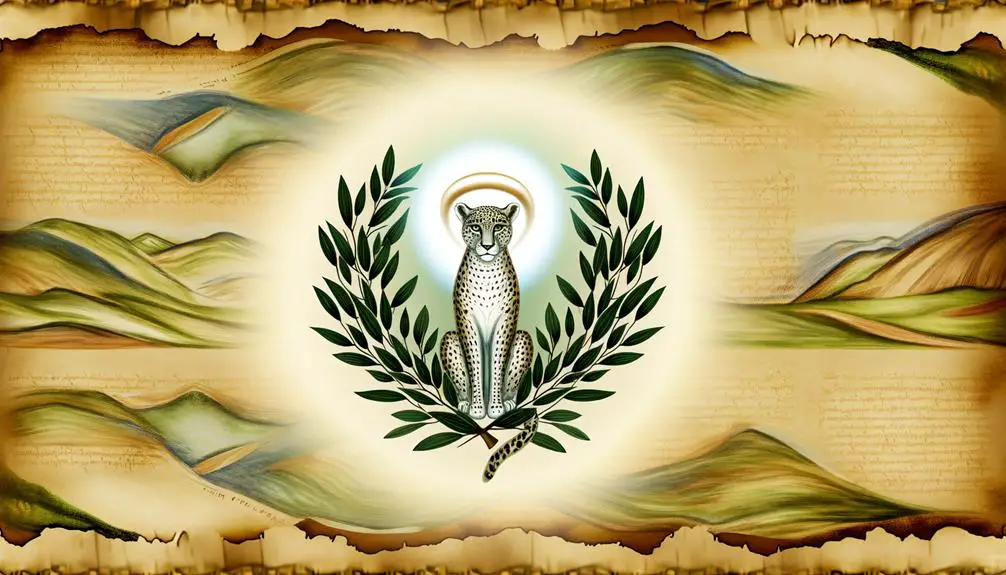Marvel at the leopard's biblical journey, where its symbolism unveils ancient prophecies and wisdom, inviting you on a fascinating exploration of spiritual mysteries.

Leopard in the Bible
In the Bible, leopards prowl through prophecies, slink within symbols, and leap across lessons, offering a rich tapestry of meaning that you've likely overlooked.
As you explore this intriguing topic, you'll find that the symbolism of leopards weaves through ancient texts, shedding light on prophecies, imparting wisdom through imagery, and providing a unique lens to view historical contexts.
But how do modern interpretations align or diverge from these ancient insights? The answer might surprise you and open up a new dimension in understanding biblical narratives, setting the stage for a compelling journey into the spiritual wilderness.
Key Takeaways
- Leopards symbolize strength, agility, and divine warnings against sin in biblical texts.
- They represent both the beauty and ferocity of nature, encouraging ecological responsibility and admiration.
- Leopard imagery in prophecy underscores transformation, divine judgment, and the accuracy of spiritual messages.
- Biblical references inspire vigilance, swift response to guidance, and a holistic view of environmental stewardship.
The Symbolism of Leopards

In biblical texts, the leopard is often symbolically employed to represent qualities such as cunning, fierceness, and unpredictability, reflecting the animal's characteristics in the natural world. This imagery draws directly from the leopard's agility and predatory nature, elements that are vividly observed in the leopard's hunting strategies and survival tactics. The leopard's ability to move silently and swiftly, coupled with its skill in ambushing prey, underscores its symbolic representation as a creature of surprise and strategy.
Analyzing the biblical context, the leopard's attributes aren't merely descriptive but carry deeper theological and moral implications. The leopard's cunning, for instance, is often paralleled with human deceit and the unpredictability of life's challenges. Its fierceness serves as a metaphor for the formidable nature of divine judgment or the presence of formidable adversaries. The agility of the leopard, meanwhile, symbolizes the need for spiritual vigilance and readiness in the face of temptation or danger.
Furthermore, the predatory nature of the leopard, characterized by its relentless pursuit and powerful attack, can be interpreted as a warning against the perils of succumbing to sin or the persistence of divine pursuit in the case of wayward souls. This multifaceted symbol, therefore, not only captures the essence of the leopard as observed in nature but also conveys complex theological themes that resonate with the human experience.
Through this analysis, it's clear that the biblical portrayal of leopards transcends mere animal description, embodying a rich tapestry of meanings that illuminate human nature, divine interaction, and the unpredictability of life's spiritual journey.
Leopards in Prophecy

Having explored the symbolic significance of leopards in biblical texts, let's now examine their role within the realm of prophecy, where they serve as potent harbingers of future events. The imagery of leopards in prophetic literature isn't merely decorative; it's rich with implications concerning the accuracy of prophecy and the specific locations these majestic creatures symbolize.
In the context of prophecy, leopards are employed to represent:
- Nations and their Characteristics: Often, the leopard's attributes, such as its stealth and ferocity, are used metaphorically to depict the nature of specific nations or peoples in prophetic texts. This symbolism can provide insight into future geopolitical dynamics.
- Divine Judgments: The presence of a leopard in prophecy can signal impending judgment or a call for repentance, highlighting the consequences of straying from divine commandments.
- Transformation and Renewal: Just as the leopard is distinct for its spots, its appearance in prophecy can signify periods of change—whether through turmoil or renewal—impacting the spiritual landscape.
- Historic and Future Events: The accuracy of prophecies involving leopards can be affirmed through historical events where leopard locations or the entities they represent played pivotal roles, underscoring the precision of prophetic insight.
The detailed analysis of leopards in prophecy not only enhances our understanding of the texts but also underscores the complex interplay between the symbolic use of animals and the accuracy of prophetic declarations. By scrutinizing leopard locations and their prophetic significance, scholars and believers alike can gain a deeper appreciation for the meticulous nature of biblical prophecy.
Lessons From Leopard Imagery

Leopard imagery throughout biblical texts offers profound lessons on the dynamic interplay between divine messages and human interpretation. You encounter leopard characteristics, not just as depictions of the animal itself, but as metaphors that enrich understanding of spiritual truths. The predatory behavior of leopards, for example, serves as a powerful allegory for both danger and the necessity of vigilance in spiritual and moral life.
To dissect these lessons further, consider the following table, which synthesizes the symbolic uses of leopard imagery in biblical narratives:
Aspect |
Leopard Characteristic |
Spiritual Lesson |
|---|---|---|
Vigilance |
Stealth and ambush |
Be watchful of spiritual dangers |
Adaptability |
Survival in various habitats |
Flexibility in faith amidst life's trials |
Speed |
Quick strikes |
Swift response to divine guidance |
Solitude |
Preference for solitary living |
Value of personal reflection and prayer |
Predatory Behavior |
Hunting prowess |
Awareness of moral and spiritual threats |
This table outlines how the characteristics and predatory behavior of leopards translate into spiritual lessons about vigilance, adaptability, swift action, solitude for reflection, and awareness of threats. These lessons suggest that the biblical use of leopard imagery isn't merely illustrative but deeply pedagogical. It invites you to reflect on your own spiritual journey, encouraging a nuanced interpretation of scripture that balances the literal and the metaphorical, the historical and the timeless. In essence, leopard imagery in biblical texts isn't just about the animals; it's a conduit for deeper spiritual engagement and understanding.
Historical Contexts

To understand the profound impact of leopard imagery in biblical texts, you must delve into the historical contexts that shaped these narratives. The use of leopards as symbols and metaphors draws from their geographic distribution and the ancient references that highlight their significance in the cultures surrounding the biblical writers.
Here are four crucial aspects to consider:
- Geographic Distribution: Leopards were prevalent in the Middle East and parts of Asia, making them a familiar sight to the ancient people in these regions. Their presence across various terrains, from forests to mountains, contributed to their mystique and symbolic potency in biblical stories.
- Ancient References: Historical texts and artifacts from civilizations such as the Egyptians, Babylonians, and Persians frequently depicted leopards. These references influenced the biblical writers, who were part of a world where leopards were symbols of power, stealth, and beauty.
- Cultural Significance: In many ancient cultures, leopards were seen as creatures of both beauty and danger. This duality made them compelling symbols for conveying complex theological and moral messages in the scriptures.
- Symbolic Use: The Bible employs leopard imagery to symbolize qualities such as fierceness, cunning, and unpredictability. These characteristics were well understood in the historical context, making the leopard an apt symbol for various narratives and teachings.
Understanding these historical contexts enriches your comprehension of the leopard's role in biblical symbolism, revealing the depth of its use in conveying spiritual and moral lessons.
Modern Interpretations

In today's scholarly discourse, we find that modern interpretations of leopard imagery in biblical texts offer a rich tapestry of insights, weaving together ancient symbolism with contemporary ethical and theological reflections. You'll notice how scholars and theologians increasingly contextualize these references to address current issues, such as leopard conservation and the evolving cultural perceptions of this majestic creature.
The biblical leopard, often symbolizing strength and stealth, now serves as a poignant emblem in discussions on biodiversity and the sanctity of life. This shift reflects a broader movement towards environmental stewardship within religious communities, emphasizing the need to protect what's often seen as God's creation. You're urged to consider how ancient texts can inspire modern conservation efforts, bridging the gap between spiritual belief and ecological action.
Moreover, cultural perceptions of the leopard have evolved. Historically viewed with a mix of awe and fear, today's interpretation extends to admiration and a call for coexistence. This change is particularly relevant in discussions around human-wildlife conflict and habitat preservation. You're invited to explore how biblical imagery can influence contemporary attitudes towards these pressing challenges.
Frequently Asked Questions
How Do Various Translations of the Bible Differ in Their Depiction of Leopards?
You'll find that various Bible translations differ significantly in depicting leopards due to distinct translation techniques and cultural interpretations. Scholars meticulously analyze ancient texts, considering the historical and cultural context, which influences their translation choices.
These differences often reflect the evolving understanding of language and the diverse ways cultures perceive leopards. Essentially, each translation offers a unique lens through which the symbolism and significance of leopards are interpreted and understood.
Are There Any Real Historical Accounts of Leopards Living in the Regions Mentioned in the Bible?
Yes, there are historical accounts suggesting leopards once roamed the regions now known as the Middle East. Imagine a study examining ancient carvings in Persia, depicting leopards in majestic poses. This not only highlights their presence but also delves into leopard symbolism, reflecting strength and stealth.
Their habitat adaptation is notable, as these creatures thrived in varied terrains, from dense forests to rocky mountains, evidencing their significant ecological footprint in biblical lands.
How Do Leopards in the Bible Compare to Other Predatory Animals Mentioned in the Text?
When comparing leopards to other predatory animals in ancient texts, you'll find that leopard symbolism often highlights characteristics like stealth and beauty, setting them apart.
Unlike the lion's brute strength or the bear's ferocity, leopards embody cunning and grace. This predator comparison reveals diverse cultural perceptions of strength and power.
Analyzing these differences, it's clear that each animal's portrayal offers unique insights into the values and fears of the societies that mentioned them.
What Role Do Leopards Play in the Dietary Laws and Cleanliness Codes of the Bible?
Leopards, like other predatory animals, aren't mentioned in dietary laws and cleanliness codes for consumption or ceremonial purity. They symbolize strength and stealth, serving as potent animal metaphors within broader narratives.
Their absence in dietary contexts highlights a distinction between the spiritual and practical, underscoring the symbolic over the literal. Analyzing these aspects reveals how leopards, through their symbolism, contribute to an enriched understanding of biblical texts, transcending mere dietary or cleanliness considerations.
Are There Any Specific Stories or Parables Outside the Bible That Parallel the Leopard's Symbolism in Biblical Texts?
You're exploring how leopard mythology and cultural interpretations parallel biblical symbolism. Leopards, in various cultures, often symbolize power, cunning, and sometimes spiritual guidance. These themes resonate with their biblical portrayal, where leopards represent swift judgment or unmatched prowess.
Conclusion
In conclusion, the leopard, with its stealth and beauty, emerges from the biblical text not merely as a creature of the earth but as a potent symbol woven into the very fabric of prophecy and moral teaching.
Like the spots that define its essence, the leopard's imagery in scripture is indelible, offering lessons that traverse time. It prompts a reflection on the perennial struggle between light and darkness, urging modern readers to discern wisdom from its silent, spotted shadow.
Through this lens, the text becomes a living tapestry, rich with meaning and ripe for exploration.



Sign up